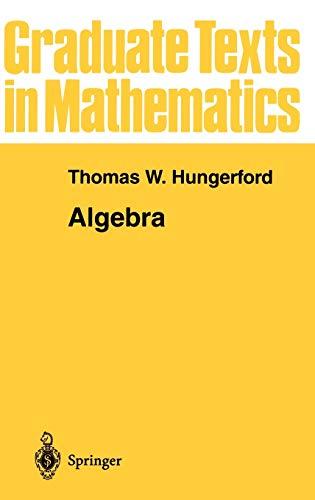The group defined by generators a, b and relations a n = e (3 n
Question:
The group defined by generators a, b and relations an = e (3 ≤ n ϵ N*), b2 = e and abab = e is the dihedral group Dn. [See Theorem 6.13.]
Theorem 6.13
For each n ≥ 3 the dihedral group Dn is a group of order 2n whose generarors a and b sarisfy:
(i) an = (1); b2 = (1); ak ≠ (1) if O < k < n;
(ii) ba = a-1b.
Any group G which is generated by elements a, b ϵ G satisfying (i) and (ii) for some n ≥ 3 (with e ϵ G in place of(1)) is isomorphic to Dn.
SKETCH OF PROOF.
Verify that a,b ϵ D,. as defined above satisfy (i) and (ii), whence Dn = (a, b) = { aibi| 0 ≤ i < n; j = 0,1} (see Theorem 2.8). Then verify that the 2n elements aibi (0 ≤ i < n;j = 0,1) are all distinct (just check their action on 1 and 2), whence |Dn| = 2n. Suppose G is a group generated by a,b ϵ G and a,b satisfy (i) and (ii) for some n ≥ 3. By Theorem 2.8 every element of G is a finite product am1bm2am3bm4, • • • bmk (mi ϵ Z). By repeated use of (i) and (ii) any such product may be written in the form aibi with 0 ≤ i < n and j = 0,1 (in particular note that b2 = e and (ii) imply b = b-1 and ab= ba-1). Denote the generators of Dn by a1,b1 to avoid confusion and verify that the map ∫: Dn → G given by a1ib1i → aibi is an epimorphism of groups. To complete the proof we show that ∫ is a monomorphism. Suppose ∫ (a1ib1i) = aibi = e ϵ G with 0 ≤ i < n and j = 0,1. If j = 1, then ai = b. and by (ii) ai+1 = aia = ba = a-1b = a-1ai = ai-1, which implies a2 = e. This contradicts (i) since n ≥ 3. Therefore j = 0 and e = aibo = ai with 0 ≤ i < n, which implies i = 0 by (i). Thus ∫(a1ib1i) = e implies a1ib1i = a1°b1° = (1). Therefore ∫ is a monomorphism by Theorem 2.3.
This theorem is an example of a characterization of a group in terms of "generators and relations." A detailed discussion of this idea will be given in Section 9.
Step by Step Answer:

Algebra Graduate Texts In Mathematics 73
ISBN: 9780387905181
8th Edition
Authors: Thomas W. Hungerford





